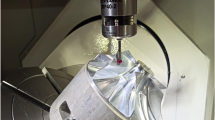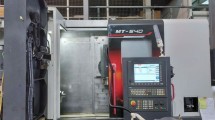Abstract
Nowadays, on-machine tool measurement (OMM) and coordinate measuring machine measurement (CMM) are the most common inspection methods. Although the ex-situ CMM measurements usually offers higher accuracy and reliability, OMM can inspect the workpiece without removing it from the machine tool. Therefore, it is possible to perform both in-process and post-process measurements, avoiding possible unclamping errors. However, due to the non-constant conditions in which machine tools usually operate, it is difficult to guarantee the traceability of measurements over time. For example, thermal fluctuations become a potential source of uncertainty.
This paper presents a methodology for ensuring the traceability of OMM on shop floor conditions. For this purpose, several features of a prismatic workpiece are measured on a five-axis machining center. The measurement results and its corresponding uncertainty budget are presented. For the uncertainty estimation the substitution method based on ISO 15530-3:2011 standard is used. In order to identify the impact of the different error sources on the results, a breakdown of the relative weights of the factors that may have an influence on the uncertainties is also given,
You have full access to this open access chapter, Download conference paper PDF
Similar content being viewed by others
Keywords
1 Introduction
The incorporation of measurement procedures into the production line has become essential under the Industry 4.0 framework. It is typical to have at least one measuring probe built into the machine tool (MT) in order to carry out quality controls where the machining process is place (in-situ). In addition to usual post-process quality controls, since the workpiece does not need to be unclamped, in-process measurements can be carried out. Unlike ex-situ CMM measurements, which are only carried out at the final stage of the manufacturing process, with OMM the entire machining phase may be monitored and controlled. Thanks to these in-process measurements, enable quicker error detection for latter correction in following machining operations. In industries like aerospace, where high value-added, high-precision customized components are required, this is a particularly appealing solution for lowering the amount of rejected components. Therefore, the main OMM advantages are [1]:
-
1.
MT geometry monitoring: By quantifying the geometrical errors caused by machine deformation over time, the machine can be self-calibrated [2].
-
2.
Workpiece alignment on MT: When the coordinate system changes between machining processes, accurate part alignment is extremely important for non-defect manufacture. The coordinate system can be more precisely reconstructed by using an appropriate measurement approach.
-
3.
Machining process: The flexibility to use the same alignment and clamping system on both the production and measurement processes is the major advantage of integrating metrology systems into MT. This has proven to be more effective than simply performing a post-process quality control, where the range of actuation is more limited.
-
4.
Workpiece quality control: Workpiece quality control: Making sure the part’s key dimensions are within tolerance before it is taken out of the machine decreases the probability that it will be deemed unsuitable during a subsequent ex-situ quality control. If the specified tolerances are not met, corrective measures can be taken while the workpiece is still clamped.
However, as the machining and measuring operations are performed on the same equipment, both operations are affected by the same geometric errors. As a result, identifying and correcting these problems becomes challenging [3]. Schmitt et al. [4] suggest two solutions to get over this restriction: volumetric calibration of the MT or integrating an external metrology system to regulate the tool tip location over time. Furthermore, the uncontrolled environment in which OMM operates (thermal fluctuations, presence of coolant oils, etc.) represent a potential source of uncertainty. This uncertainty assesses the reliability of the measurement and determines the quality of the results. Therefore, decreasing the measurement uncertainty is a challenging task.
Three uncertainty estimation methods have been developed based on GUM ISO Guide 98-3:2008. The ISO 15530-3 stabilizes the traceability chain using a calibrated reference artifact and is based on the substitution approach. ISO 15530-4, on the other hand, calculates the uncertainty through an iterative simulation-based process. Finally, VDI guideline 2617-11 estimates the influence of each error source on each measurement independently.
In this study, the substitution method is used to assess the uncertainty of numerous properties of a prismatic part under OMM conditions (ISO 15530:3 standard). A CMM was used to calibrate them in order to have their reference value [5].
2 Methodology
2.1 Measurement Strategy
The targeted component is a prismatic workpiece made of 7075 aluminum (100 mm × 100 mm × 50 mm). The intersection of planes A and B (X-axis), the intersection of planes B and C (Z-axis), and the intersection of planes A, B, and C (origin “P”) were used to establish the coordinate system (CS) (see Fig. 1).
Using these geometric elements, five dimensional tolerances (references 101–105) seven form errors (references 201–207), five orientation tolerances (references 301–305) and three position tolerances (references 401–403) were analyzed (see Table 1).
2.2 Uncertainty Estimation
The OMM was performed ten times on an Ibarmia THR16 Multiprocess five-axis machining center using a 100 mm long and 6.048 mm touch probe (1m repeatability). Using a coverage factor of k = 2, the expanded uncertainty (UMP) was estimated (Eq. 1).
The calibration of reference values (ucal), process repeatability (up), and systematic error correction (ub) contribute to the estimation of the measuring process uncertainty. Bias (b), which is the difference between the calibrated and measured values, can influence the uncertainty in two ways. If it remains constant over the measurements, it can be categorized as a systematic error and corrected using Eq. 2, where y̅cal is the average of the calibrated measurement; y̅ is the average of the OMM; yMP is the uncorrected OMM value and YMP is the corrected value.
If not, bias must be taken into account as an extra source of uncertainty. In this study, the first option was chosen since bias did not change over the repetitions. Thus, the component ub is only influenced by the workpiece’s temperature T, the material’s uncertainty in its thermal expansion coefficient (uα = 4.702 \( \cdot \) 10−6mm/ºC) and the measurement length L (Eq. 3):
The repeatability of the process, assessed as the standard deviation of the measurements contributes to up, where y̅ is the mean value of the feature, yi is the measured value for repetition i and n is the number of repetitions (Eq. 4).
The part was measured using a 55 mm long, 5 mm stylus and a Mitutoyo Crysta Apex S9106 3+2 axis CMM (positional repeatability of 0.4 m at 100 mm). Equations 5 and 6 give the characteristics of the CMM, where MPE stands for the maximum permissible error, A is equal to 1.7 μm, B is equal to 0.003 μm/mm, L is the measurement length, MPEp is the maximum probing error (1.7 μm) and σi is the standard deviation of the calibration error for each stylus configuration.
This component ucal was estimated according to the ISO 15530:2 standard, with ugeo indicating the reproducibility of the measurement process uE the calibration uncertainty of the CMM, and urep its repeatability (Eq. 7) [5].
The ugeo component is related to the geometric inaccuracies of the CMM. The part was measured using four different probe configurations to evaluate them independently (Eq. 8). In this equation, n2 is the number of probe configurations, jy̅ is the mean value in orientation j and y̅ is the mean value across all configurations:
According to the type of the assessed feature (Table 1), uE was estimated using one of the following equations [6] (Table 2):
Finally, Eq. 4 was used to estimate urep, replacing the OMM results with those got in CMM. 20 repetitions were made in this instance (5 per probe configuration).
3 Results
For quality control, reliable measurements are crucial, but as OMM is vulnerable to numerous variable sources of error, this is difficult to guarantee. To ensure OMM traceability, this study conducts an experimental test in accordance with ISO 15530-3:2011 standard identifying the main error sources that influence the uncertainty (Fig. 2).
The findings indicate that the workpiece calibration uncertainty ucal is primarily caused by the CMM calibration component uE. With the exception of the angular tolerance (uE = 0º by definition) and the position tolerances, where reproducibility is more crucial, its weight exceeds 50% in the majority of circumstances. This, in turn, increases the subsequent value of UMP.
In contrast, for OMM, repetition becomes the main source of uncertainty. The repeatability of the measuring process decreases increasing weight of up by as much as 90%, when rotatory table interpolation is required, as for measuring C or F planes.
It is important to note that the ub component remained less than 1 μm in every case that was examined. Due to the small size of the prismatic part and as the test’s temperature (\(18.37\,^\circ {\text{C}}\)) remains so close to the reference temperature of \(20\,^\circ {\text{C}}\), its impact was nearly nonexistent. However, the contribution of this component to the uncertainty would be more substantial for larger components or if the temperature changes rise.
4 Conclusions
An overview of the relative contributions of each measurement uncertainty source to OMM is given in this paper. The main cause of uncertainty turned out to be the lack of repeatability brought on by the unpredictable climatic conditions and the presence of coolant oils, particularly when the machine’s rotating axes were interpolated. In addition, the use of a different calibration device is suggested for future investigations in order to decrease the weight of uE in the overall measurement uncertainty.
References
Mutilba, U., Gomez-Acedo, E., Kortaberria, G., Olarra, A., Yagüe-Fabra, J.A.: Traceability of on-machine tool measurement: a review. Sensors 17(7), 1605 (2017)
Ding, D., Zhao, Z., Li, Y., Fu, Y.: Calibration and capability assessment of on machine measurement by integrating a laser displacement sensor. Int. J. Adv. Manuf. Technol. 113(7), 2301–2313 (2021)
Wang, S., Cheung, C., Kong, L.: A fiducial-aided reconfigurable artefact for the estimation of volumetric errors of multi-axis ultra-precision machine tools. Appl. Sci. 12(4), 1824 (2022)
Schmitt, R., Petere, M.: Traceable measurements on machine tools-Thermal influences on machine tool structure and measurement uncertainty. Procedia CIRP 33, 576–580 (2015)
Sładek, J.A.: Coordinate Metrology. Accuracy of systems and measurements (2016)
Cheng, Y., et al.: Evaluation and optimization of task-oriented measurement uncertainty for coordinate measuring machines based on geometrical product specifications. Appl. Sci. 9(1), 6 (2018)
Acknowledgements
Grant KK-2021/00039 founded by Department of the Basque Government’s Ministry of Economic Development, Sustainability and Environment.
Author information
Authors and Affiliations
Corresponding author
Editor information
Editors and Affiliations
Rights and permissions
Open Access This chapter is licensed under the terms of the Creative Commons Attribution 4.0 International License (http://creativecommons.org/licenses/by/4.0/), which permits use, sharing, adaptation, distribution and reproduction in any medium or format, as long as you give appropriate credit to the original author(s) and the source, provide a link to the Creative Commons license and indicate if changes were made.
The images or other third party material in this chapter are included in the chapter's Creative Commons license, unless indicated otherwise in a credit line to the material. If material is not included in the chapter's Creative Commons license and your intended use is not permitted by statutory regulation or exceeds the permitted use, you will need to obtain permission directly from the copyright holder.
Copyright information
© 2023 The Author(s)
About this paper
Cite this paper
González, G., Medina, B.E., Ortega, N., Plaza, S., Gómez, G. (2023). 5-Axis Machining Center OMM Uncertainty Estimation. In: Vizán Idoipe, A., García Prada, J.C. (eds) Proceedings of the XV Ibero-American Congress of Mechanical Engineering. IACME 2022. Springer, Cham. https://doi.org/10.1007/978-3-031-38563-6_56
Download citation
DOI: https://doi.org/10.1007/978-3-031-38563-6_56
Published:
Publisher Name: Springer, Cham
Print ISBN: 978-3-031-38562-9
Online ISBN: 978-3-031-38563-6
eBook Packages: EngineeringEngineering (R0)






